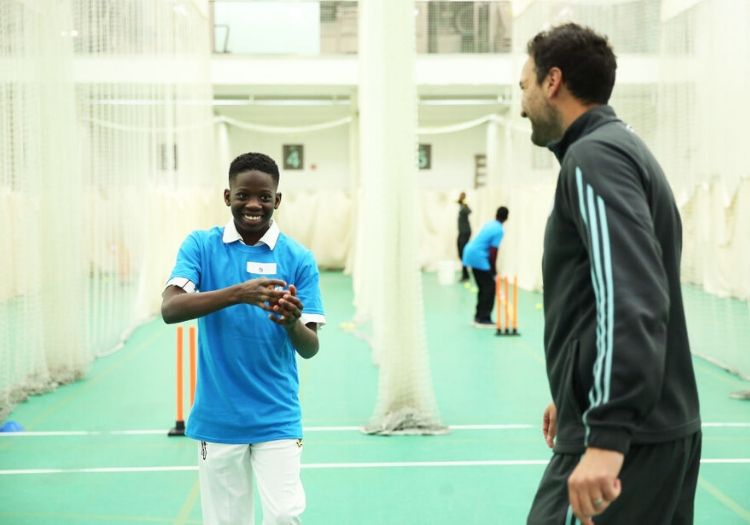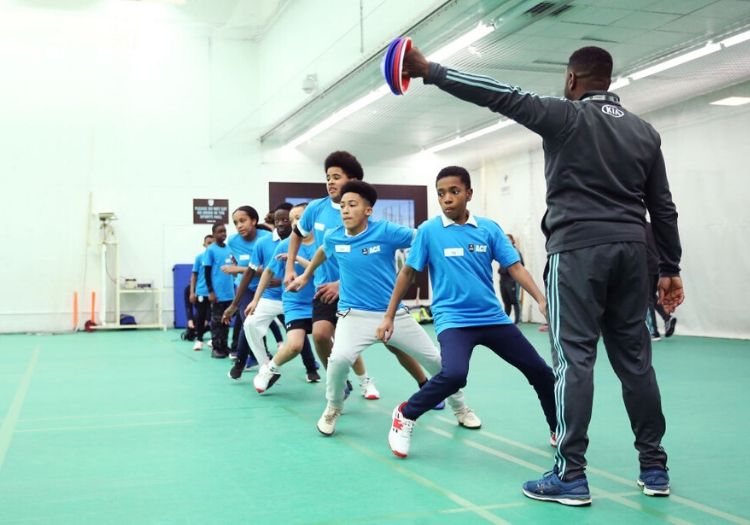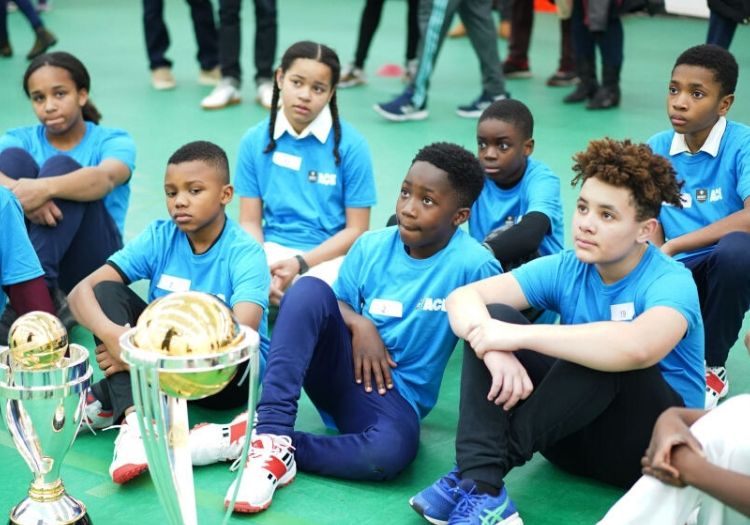The essence of the county's African-Caribbean engagement programme is in breaking down barriers and in making up for lost time. The room is full of enthusiasm on launch night, with parents watching on, balls flying and youngsters getting stuck in

Among the parents hovering at the back of the hall, one stands out. She is looking on with a quiet enthusiasm and wears a maternal gaze as she watches over proceedings with an understated pride, her face complete with an approving smile.
The Oval’s Ken Barrington Centre is playing host to the first evening of open trials for Surrey’s African-Caribbean engagement programme.
Two groups – youngsters followed by older teenagers – are being put through their paces for an hour each; part of this is about discovering untapped talent, but its wider purpose is in reconnecting with a community that has become detached from its local club and, by extension, the game of cricket.
As bowling machines fire up and participants fling themselves onto catching mats, I wander over to the mystery mother and ask which child is hers.
“I’m Ebony’s mum,” grins Janet Rainford. Her daughter is here and not here: absent because she is commentating in Australia, but present because this night was a pipedream of her own making. Geographically, she could not be further from home, but spiritually she can never have felt closer to a club that carries her soul.
ACE, as the initiative is known, is the brainchild of Ebony Rainford-Brent. She is the heartbeat behind this vitally important project and, as the first black woman to play for England, an example of what is possible.
“I don’t like shouting about what I do,” she told The Cricketer back in January, “but there’s a moment – like right now – where I realise how important it is to have been the first and to be young enough to be able to do something like this and to be in a club which just gets it.”
The county has been her life: as a player, captain and now as director of women’s cricket. She became a World Cup winner during her time here and is one of the sport’s most recognisable and well-respected voices.
Did she ask her mother to come along tonight in her place? “No, no, no,” Janet laughs, her face beaming with joy at all that the evening represents.
“I’ve been saying: ‘Can I come down? Can I help with the tea? Can I do this or that?’ She was happy for me to come down – I think she was shocked.
“We used to talk about stuff like this long before. We’d be like: ‘Wouldn’t it be awesome? Wouldn’t it be awesome if…?’
“And then she phoned me, screaming down the phone: ‘Mum, guess what. I’ve put it to them and they’ve said yes!’”
The scheme is “about reaching out and engaging,” Ebony explained. “But it’s about relating. If the kids don’t know that people care about them and are trying to do stuff for the community, it’s just going to pass them by.
“If you invest, put time in, show you care and try to build these relationships, suddenly everyone becomes very excited.”
The programme targets children between the ages of 11 and 18, seeking to find those with sporting potential, with the ambition of offering scholarships to the best, who then enter Surrey’s age-group system. Gareth Townsend, the club’s academy director, is on hand to patrol the room’s perimeter and cast his eye over the youngsters. It is about more than simply strengthening the production line, though.

The African-Caribbean engagement programme is the brainchild of Ebony Rainford-Brent
“Ultimately, the long-term ambition from this project is to get someone to walk out wearing the Surrey badge out onto the field,” explains Jeremy Greaves, Surrey Cricket Centres manager and an employee of the county for 19 years. He also works with the academy and, once upon a time, coached Ebony.
“It is just about people enjoying it – engaging, which is part of the slogan, and enjoying cricket – and Surrey cricket. This is the community, people that are hopefully close to the Oval. To get here, maybe to be on the scholarship, is not too far. But also, to come and watch a game is not too far. Hopefully, we’re engaging people in that way.”
The Surrey Cricket Foundation and the African-Caribbean Cricket Association have both been heavily involved in the setup of the scheme.
The essence of the project is in breaking down barriers and in making up for lost time. When the programme was first unveiled, Ebony suggested that Surrey had “missed a generation and a half – maybe even more, maybe 20 years’ worth” of potential players and spectators from around the local area. Just one per cent of recreational cricketers are from the black community.
On the professional circuit, only nine black players featured in men’s county cricket in 2019, down from 33 in 1994. There were just three in the women’s domestic game last year. In the history of men’s county cricket, there have been just three black head coaches.
“Dismal,” Janet says of the numbers.
“Projects like this are what is needed, absolutely,” Greaves adds. “When we look at the statistics, there is clearly a decline of players across the board.”
The goal is to rebuild relationships with a community that has, by and large, been lost to English cricket in recent years.
It is not just about creating cricketers, but rather letting people in. All those who attend these initial open days will receive a membership, allowing them to attend Surrey matches free of charge, alongside an adult.
“I think a lot of people won’t believe it,” Janet chuckles. “They’ll be a little bit suspicious – like, what’s the catch? If someone came up to you and said they were giving you all of this, how would you feel?
“It will be interesting to see how it develops, but I’m sure the numbers are going to get better and better. When they start to trust that this is real, you’ll find more kids coming through. For some people, they’re fed up of disappointment. They don’t want to start and find two weeks down the road that it’s over.”

29 children came along to the first taster evening
Richard Gould, the club’s chief executive, admits that this is an overdue move. A club, after all, should be representative of its community. “It’s really important,” he tells The Cricketer.
“The stat of 10 to 18-year-olds in SE11, 42 per cent are black youngsters. And of the youngsters I see coming into this club, 42 per cent of them aren’t black.
“We’re clearly not being sufficiently welcoming and not being sufficiently proactive, and so we have to make sure that changes.
“It can’t be a flash in the pan. We’re getting positive, smiley faces – people going: ‘Yeah, that makes sense.’ And it does make sense – the only thing that doesn’t make sense is perhaps why we haven’t had the focus to do this before. We have to accept that we’re at fault for that.”
On the back of a World Cup year, however, the finances are available, and the hope is that the ECB will like what they see; the model is straightforward and transferable. Gould believes this could be rolled out across different target demographics and, indeed, in other parts of the country.
On a rain-soaked evening in south London, the turnout for the first session is encouraging – 29 boys and girls across two groups, with some genuine cricketing ability on show and another similar taster night to come. A specific event has been set up for the pupils of the nearby Archbishop Tenison’s school, who have already started using the county’s facilities on Friday afternoons.
“It’s been a long road,” Greaves admits. “The project has been swirling around for quite a while in the background. It has been driven brilliantly by Ebony, but it isn’t just turning up and doing this.
“There has been a lot of planning into what we want, how we want it, so we can see the skills that participants have. That’s the fun of it – bringing these projects to life and making them happen, that’s what we do. It’s the buzz part. We’re seeing the talent in the hall, and there is lots of talent.”
It is a while before Greaves, who was introduced to the game by his father, comes over to the back of the net area for a chat. He is reticent to leave behind the management of his session. First impressions are key, and his role is in capturing the imaginations of those who have come along.
“The main thing that really shines out is that they’re athletic,” he smiles, gazing around at a room full of willing youngsters. Greaves is a man in his element during a heartwarming hour, before the men’s and women’s World Cup trophies are brought out for photo opportunities.
“Every participant tonight will get a membership,” he says. “Hopefully, that will encourage them to come. From there, there is hope that there is a means; they don’t have to pay for it and they can come to watch some cricket. Just having that understanding that I can go and watch sometimes is the motivation that people need.
“There is an element of it that’s making sure we engage the parents as well.”

Surrey hope that the initiative can be replicated nationwide
Janet is proof. One of her greatest thrills now is turning on the television and hearing her daughter’s voice on any of several channels.
Her mind harks back to the early days, when Ebony had only just found the game through the Cricket for Change charity that ran classes during her time at primary school.
“There was nobody else who we knew; we didn’t drive, we didn’t care, but she was just so enthused and committed, so it would have been a shame if somebody didn’t stick with her,” she reflects.
“So, if anyone else wonders what could make the difference, it’s having the parents’ backing and commitment – even though I know it’s difficult. If the parent or grandparent can’t go, just somebody. Sometimes, they need a little bit of support.”
Janet confesses that initially she knew little of the game and of why her daughter might be so excited by it, but that – in itself – didn’t matter.
“The thing is this: I don’t know, but I don’t have to know,” she explains. “What I need to know is that my child is happy. That is it. Full stop. That’s it really – the commitment and whatever it took in terms of having her happy.”
And years on, this is the result – a programme set up to inspire a new generation in a community that means so much to both mother and daughter.
“For her, it’s a combination of wanting to see kids blossom and also talking about the black side of it,” Janet explains.
“She wants people – instead of saying we haven’t got any opportunities – to realise it is out there. Now, there’s people here offering. If somebody is offering and you really want it, come on kids.
“If the parents won’t go, get independent and form a group and come down. Find a way around it – it’s not as hard as it used to be. Even with the girls, I don’t think it’s as hard as it used to be – even with the older girls, they’re getting independent. Cricket is now an option.
“Cricket is like life. You have to get stuck in and be committed. It doesn’t matter if it rains – you have to turn up. When you get there, they’ll tell you when you can go home. That’s what I’ve always liked about it; it was good training for me. After that, I didn’t have to worry about Ebony because it was embedded in her – a commitment in whatever she does.”
The pair would practise together across the road from their home, throwing balls to one another. In the back garden, Janet tied a string to a ball-filled sock – a homemade Swingball, so to speak.
She recalls stepping in years later when, midway through her Masters at university, Ebony was included in England’s World Cup squad. She had been told by her tutors that her studies should come first – this, at a time long before central contracts. “She asked me what she should do,” Janet laughs.
“I said: ‘Put it this way, hon. As a mother I’m supposed to tell you to finish your Masters. But as a parent, I’m telling you to go. I’ll deal with the consequences when you come back – and so will you. But go.’
“I’m proud of her, but I’ve always been proud of her.”
Watching on from the back of the nets as her daughter’s initiative comes to life, you sense this has rarely been truer.